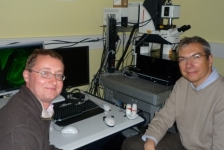|
This meeting will cover the current state of the art in the field of melanocortin-related research. The melanocortin system is involved in many aspects of physiology such as pigmentation, the HPA axis, regulation of energy balance and of sexual behavior. Similar to the 5th International Melanocortin meeting in Sunriver, Oregon, 7 years ago, we aim to cover the melanocortin field broadly: melanocortin genetics, melanocortin physiology, peripheral actions of melanocortins, human melanocortin genetics, melanocortin pharmacology, functional neuroanatomy of the melanocortin system, central actions of melanocortins, clinical studies with melanocortins and receptor structure function. Main players in the field have accepted the invitation to speak, and we are looking forward to an excellent symposium.
Brain plasticity is now recognized to occur in numerous neuronal systems throughout development and ageing. Since the pioneering work on magnocellular neurons and their afferent inputs demonstrating dramatic morphological changes in response to lactation and dehydration, similar structural remodeling has been observed in other hypothalamic neuroendocrine control systems, particularly those regulating ovarian cyclicity and seasonal changes in reproduction. In this regard, there is increasing evidence that at specific stages of reproductive life, the hypothalamic arcuate nucleus and preoptic area undergo plastic structural changes in order to co-ordinate the initiation of appropriate behaviour and neuroendocrine secretion. This remodelling may be subtle, operating simply at the level of cell-cell interactions, or more pronounced, involving cell birth and differentiation. This symposium will document the tremendous plasticity of neuroendocrine systems (including components within the pituitary) that is observed across vertebrate species, and also highlight how particular reproductive hormones may profoundly impact the shaping of the micro-anatomy and function of many regions of the brain. Review articles resulting from this satellite symposium will be published in a special issue of the European Journal of Neuroscience. The deadline for early-birds registration and abstract submission has been extended to April 30th 2010 For more information, please click here
Cellular imaging methods are currently offering unprecedented precision in the examination of neuronal structures and dynamic processes. Preceding the ICN2010 meeting, a 2-day workshop entitled ‘Recent Progress in Cellular Imaging for Neuroscience Research’ will be held at the Rouen University House in Mont-Saint-Aignan to present some of the new technical approaches that have emerged over the last few years and which may be of key importance to unravel neuronal functions. The workshop will include: 5 presentations by invited speakers who are using these innovative approaches , 10 short communications selected from the abstracts submitted by the participants, a poster session (with prizes) and a dozen of practical trainings and demonstrations (Tracking neuronal migration by macroconfocal; Confocal acquisitions with a white laser; Time laps videomicroscopy of microexplants; Coupling laser microdissection with real time PCR…) on various equipments available on the Cell Imaging Platform of Haute-Normandie (PRIMACEN) or provided by our partners. The program and the registration form will be available on March 1st. The number of participants is limited to 100 so the registration will be on a first-applied, first-served basis. The deadline for abstract submission has been extended to May 15th 2010 For more information, please click here
Endocrine disruptors (EDs) are natural or synthetic compounds that can interfere with the normal development and functioning of the endocrine systems. Although EDs potentially affect organisms throughout their entire lifespan, recent data indicate that their effects are particularly deleterious when exposure occurs during foetal and early postnatal development. Effects of estrogenic EDs on reproductive functions are now well recognized, although the underlying mechanisms are poorly understood. In addition, there is increasing evidence that EDs can also target other neuroendocrine functions. This symposium aims at discussing recent data on the effects of EDs on neuroendocrine functions, from the molecular interactions to the behavioral consequences, across the life cycle of invertebrates and vertebrates. Review articles resulting from this satellite symposium will be published in a special issue of the Journal of Toxicology and Environmental Health.
The incidence of obesity is increasing at an alarming rate and this worldwide epidemic represents an ominous predictor of increases in diseases such as type 2 diabetes and metabolic syndrome. Epidemiological and animal studies suggest that maternal obesity and alterations in postnatal nutrition are associated with increased risks for obesity, hypertension, and type 2 diabetes in the offspring. Furthermore, there is also growing appreciation that developmental programming of neuroendocrine systems by the perinatal environment represents a possible cause for these diseases. This symposium will provide a synthesis of recent evidence concerning the actions of perinatal hormones and nutrition in programming the development and organization of neural pathways that regulate body weight and energy balance. |
||||||||||||||||||||||||||||||||||||||||||||||||||||||||
Last update: February 10, 2017 - Designed by Alexis Lebon, 2007-2010










